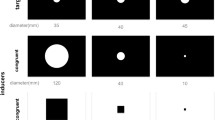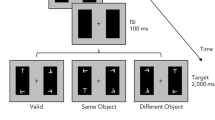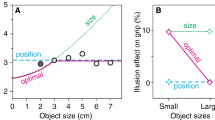Abstract
Reaching out for an object is often described as consisting of two components that are based on different visual information. Information on the object's position and orientation guides the hand to the object, while information on the object's shape and size determines how the fingers move relative to the thumb to grasp it. We propose an alternative description, which consists of determining suitable positions on the object — on the basis of its shape, surface texture, and so on — and then moving one's thumb and fingers to these positions. This could lead to the same performance without requiring distinct visual information on the object's orientation or size. If so, an illusory change in size need not influence the distance between thumb and fingers when reaching out for an object. However, as the object's size is used to estimate its weight, the illusory change in size should influence the force that is exerted to lift the object. To find out whether this is so, eight subjects were asked to pick up brass disks from a fixed position straight in front of them. The illusory change in size was brought about by presenting five converging lines in two different configurations under the disks. As predicted, the illusion influenced the force used to lift the disks, but not the distance between the subjects' thumbs and fingers when reaching for the disks.
Similar content being viewed by others
References
Abrams RA, Landgraf JZ (1990) Differential use of distance and location information for spatial localization. Percept Psychophys 47:349–359
Aglioti S, DeSouza JFX, Goodale MA (1995) Size-contrast illusions deceive the eye but not the hand. Curr Biol 5:679–685
Brenner E, Smeets JBJ (1996) Hitting moving targets: co-operative control of “when” and “where”. Hum Mov Sci 15:39–53
Brenner E, Van den Berg AV,DammeWvan (1996) Perceived motion in depth. Vision Res 36:699–706
Bridgeman B, Lewis S, Heit G, Nagle M (1979) Relation between cognitive and motor-oriented systems of visual position perception. J Exp Psychol Hum Percept Perform 5:692–700
Bridgeman B, Kirch M, Sperling A (1981) Segregation of cognitive and motor aspects of visual function using induced motion. Percept Psychophys 29:336–342
Goodale MA, Milner AD (1992) Separate visual pathways for perception and action. Trends Neurosci 15:20–25
Goodale MA, Pelisson D, Prablanc C (1986) Large adjustments in visually guided reaching do not depend on vision of the hand or perception of target displacement. Nature 320:748–750
Gordon AM, Forssberg H, Johansson RS, Westling G (1991a) Visual size cues in the programming of manipulative forces during precision grip. Exp Brain Res 83:477–482
Gordon AM, Forssberg H, Johansson RS, Westling G (1991b) Integration of sensory information during the programming of precision grip: comments on the contributions of size cues. Exp Brain Res 85:226–229
Iberall T, Bingham G, Arbib MA (1986) Opposition space as a structuring concept for the analysis of skilled hand movements. In: Heuer H, Fromm C (eds) Generation and modulation of action patterns. (Experimental Brain Research series, vol 15) Springer, Berlin Heidelberg New York, pp 158–173
Jeannerod M (1986) The formation of finger grip during prehension. A cortically mediated visuomotor pattern. Behav Brain Res 19:99–116
Jeannerod M, Paulignan Y, Mackenzie C, Marteniuk RM (1992) Parallel visuomotor processing in human prehension movements. In: Caminiti R, Johnson PB, Burnod Y (eds) Control of arm movement in space: neurophysiological and computational approaches. Springer, Berlin Heidelberg New York
Johansson RS, Westling G (1984) Roles of glabrous skin receptors and sensorimotor memory in automatic control of precision grip when lifting rougher or more slippery objects. Exp Brain Res 56:550–564
Livingstone M, Hubel D (1988) Segregation of form, color, movement, and depth: anatomy, physiology, and perception. Science 240:740–749
Loomis JM, Da Silvva JA, Fujita N, Fukusima SS (1992) Visual space perception and visually directed action. J Exp Psychol Hum Percept Perform 18:906–921
Smeets JBJ, Brenner E (1995) Perception and action based on the same visual information: distinction between position and velocity. J Exp Psychol Hum Percept Perform 21:19–31
Zeki S, Shipp S (1988) The functional logic of cortical connections. Nature 335:311–317
Author information
Authors and Affiliations
Rights and permissions
About this article
Cite this article
Brenner, E., Smeets, J.B.J. Size illusion influences how we lift but not how we grasp an object. Exp Brain Res 111, 473–476 (1996). https://doi.org/10.1007/BF00228737
Received:
Accepted:
Issue Date:
DOI: https://doi.org/10.1007/BF00228737




